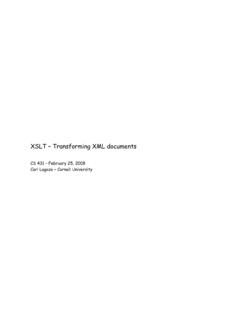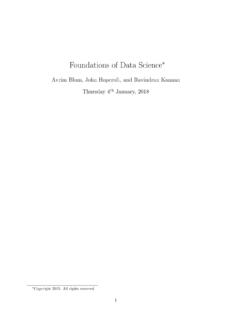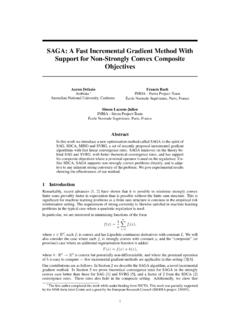Transcription of SAGAS Abstract
1 SAGAS Hector Garcaa-Molrna Kenneth Salem Department of Computer Science Princeton University Princeton, N J 08544 Abstract Long lived transactions (LLTs) hold on to database resources for relatively long periods of time, slgmficantly delaymg the termmatlon of shorter and more common transactions To alleviate these problems we propose the notion of a saga A LLT 1s a saga if it can be written as a sequence of transactions that can be interleaved with other transactions The database manage- ment system guarantees that either all the tran- sactions m a saga are successfully completed or compensatmg transactions are run to amend a partial execution Both the concept of saga and its lmplementatlon are relatively simple.
2 But they have the potential to improve performance slgmficantly We analyze the various lmplemen- tatron issues related to SAGAS , including how they can be run on an exlstmg system that does not directly support them We also discuss tech- niques for database and LLT design that make it feasible to break up LLTs mto SAGAS 1. INTRODUCTION As its name indicates, a long lived transac- tron 1s a transactlon whose execution, even without interference from other transactions, takes a substantial amount of time, possibly on the order of hours or days A long lived transac- tion, or LLT, has a long duration compared to Permlsslon to copy wlthout fee all or part of this material IS granted provided that the copies are not made or dlstrlbuted for direct commercial advantage.
3 The ACM copyrlght notice and the title of the pubhcatlon and Its date appear, and notlce IS given that copymg IS by permlsslon of the Assoclatlon for Computmg Machmery To copy otherwlse, or to repubhsh, requires a fee and/or specfic permisslon 0 1987 ACM O-89791-236-5/87/0005/0249 75@ the malorlty of other transactions either because it accesses many database obJects, it has lengthy computations, it pauses for inputs from the users, or a combmatlon of these factors Examples of LLTs are transactions to produce monthly account statements at a bank, transactions to process claims at an insurance company, and transactions to collect statrstlcs over an entire database [Graysla] In most cases, LLTs present serious perfor- mance problems Since they are transactions, the system must execute them as atomic actions, thus preserving the consistency of the database [DateSla,Ullm82a]
4 To make a tran- saction atonuc, the system usually locks the objects accessed by the transaction until It com- mits, and this typically occurs at the end of the transactlon As a consequence, other transac- tions wishing to access the LLT s objects suffer a long locking delay If LLTs are long because they access many database obJects then other transac- tions are likely to suffer from an mcreased block- mg rate as well, 1 e they are more likely to conflict with an LLT than with a shorter transac- tion Furthermore, the transaction abort rate can also be increased by LLTs As discussed m [Gray8lb], the frequency of deadlock 1s very sensitive to the size of transactions, that IS, to how many oblects transactions access (In the analysis of [GraySlb] the deadlock frequency grows with the fourth power of the transaction size )
5 Hence, since LLTs access many oblects, they may cause many deadlocks, and correspond- ingly, many abortions From the point of view of system crashes, LLTs have a higher probability of encountering a failure (because of their duration), and are thus more likely to encounter yet more delays and more likely to be aborted themselves 249 In general there 1s no solution that ehm- mates the problems of LLTs Even d we use a mechanism different from locking to ensure atom- lclty of the LLTs, the long delays and/or the high abort rate ~111 remam No matter how the mechanism operates, a transactlon that needs to access the objects that were accessed by a LLT cannot commit until the LLT commits However.
6 For specific applreatsons lt may be possible to alleviate the problems by relaxing the requirement that an LLT be executed as an atormc actlon In other words, without sacrlficmg the consistency of the database, it may be possl- ble for certain LLTs to release their resources before they complete, thus permitting other walt- mg transactions to proceed To illustrate this idea, consider an alrhne reservation apphcatlon The database (or actu- ally a collection of databases from different air- lines) contams reservations for flights, and a tran- saction T wishes to make a number of reserva- tions, For this dlscusslon, let us assume that T IS a LLT (say It pauses for customer input after each reservation)
7 In this apphcatlon It may not be necessary for T to hold on to all of its resources until it completes For instance, after T reserves a seat on flight Fl, it could lmmedl- ately allow other transactions to reserve seats on the same flight In other words, we can view T as a collection of sub-transactions T1, Tz, , T,, that reserve the mdlvldual seats However, we do not wish to submit T to the database management system (DBMS) simply as a collection of independent transactions because we still want T to be a unit that IS either suc- cessfully completed or not done at all We would not be satisfied with a DBMS that would allow T to reserve three out of five seats and then (due to a crash)
8 Do nothmg more On the other hand, we would be satisfied with a DBMS that guaranteed that T would make all of its reservations, or would cancel any reservations made If T had to be suspended This example shows that a control mechan- ism that 1s less rlgld than the conventional atomic-transaction ones but still offers some guarantees regardmg the execution of the com- ponents of an LLT would be useful In this paper we will present such a mechamsm Let us use the term eaga to refer to a LLT that can be broken up mto a collection of sub- transactions that can be mterleaved m any way with other transactlons Each sub-transactlon m this
9 Case 1s a real transaction m the sense that it, preserves database consistency However, unlike other transactions, the transactions m a saga are related to each other and should be executed as a (non-atomic) unit any partial executions of the saga are undesirable, and if they occur, must be compensated for To amend partial executions, each saga transaction T, should be provided with a com- pensating transaction C, The compensatmg transaction undoes, from a semantic point of view, any of the actions performed by T,, but does not necessarily return the database to the state that existed when the execution of T, began In our airline example, if T, reserves a seat on a flight, then C.
10 Can cancel the resewa- tlon (say by subtracting one from the number of reservations and performing some other checks) But C, cannot simply store m the database the number of seats that existed when T, ran because other transactions could have run between the time T, reserved the seat and C, canceled the reservation, and could have changed the number of reservations for this flight Once compensating transactions Cl, Cs, c n-1 are defined for saga T1, Tz, T,,, then the system can make the followmg guarantee Either the sequence Tl, T2, T?



















